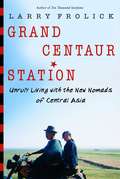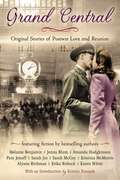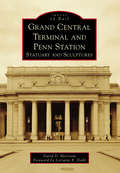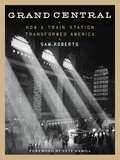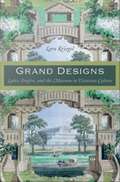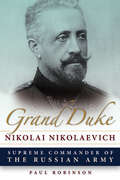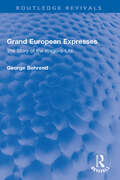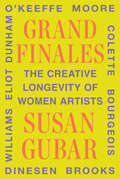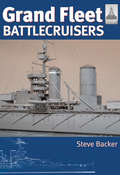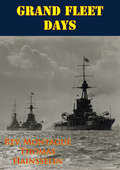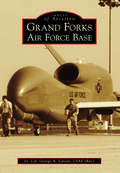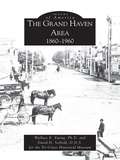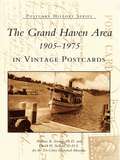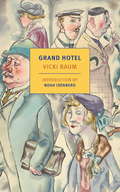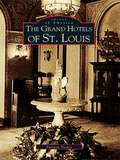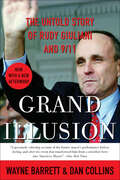- Table View
- List View
Grand Canyon's Tusayan Village (Images of America)
by Patrick WhitehurstWith the glamorous Grand Canyon as its backyard, Tusayan has a fascinating history. Dedicated just one year after the Grand Canyon National Park, the village of Tusayan had its humble beginnings in 1920 as a small sheep ranch operated by the Hull brothers. Tusayan quickly became a hub for the millions of travelers who made their way to the Grand Canyon each year. The two areas share a mutual school, a health care center, and other amenities. Other pioneers, such as R. P. Thurston, helped ensure the area's longevity with the addition of Highway 64 through the center of the village and the arrival of the Grand Canyon Airport, making Tusayan one of the most visited little towns in northern Arizona.
Grand Canyon, The: Native People and Early Visitors
by Kenneth Shields Jr.Unlike appreciating America's other natural wonders such as waterfalls, glaciers, mountains, or prairies, one must struggle to absorb, assimilate, and comprehend the Grand Canyon's tremendous scale. Captured here in over 250 vintage images is the human drama of survival and coexistence in the canyon, from the native tribes who struggled with life on the rim, to the pioneers who came to foster and manipulate the early tourist industry in America's oldest natural resource. Covering the tribes that called the canyon home and the seekers who flocked to the area to find their fortune in gold and tourism, author Kenneth Shields exposes the human layers so often overlooked. Seen here are the native tribes who survived the harshest conditions of the canyon, including the Hopi, Havasupai, Navajo, and Paiute. Readers will recognize the images of popular tourist spots like the El Tovar Hotel and the Navajo Bridge, as well as the early conservationist faces of Presidents Theodore Roosevelt and William Taft.
Grand Centaur Station: Unruly Living With the New Nomads of Central Asia
by Larry FrolickWith the grim determination of an unrepentant rocker, Larry Frolick sets off on a 12,000-mile trek across Central Asia, brooding over the fate of its lost civilizations. From Kiev, Crimean Tartary, and Moscow, through the nomadic homelands of Uzbekistan, Kyrgizstan, Tien-Shan, and finally into distant Mongolia and Siberia, he explores a continent on the brink of a meltdown, a strange world lit harshly by the red afterglow of the Soviet collapse. His vivid account opens the door to a crowd of unlikely strangers: Mafiosi flatheads, salt-mine campers, fractious archaeologists, a conceptual artist who uses fresh corpses in his window displays, the very last of three Romanov princesses, an inept Chinese secret agent, a relentless Uzbek glottal probologist, disgruntled e-mail swains – and above all, Larissa, the moody Eurasian beauty who “just stepped out of a novel in her impossibly pointy Italian shoes. ” With gleeful wit and a steely eye for detail, Frolick transports the reader to a world inhabited by a people burning with desire for something new to happen.
Grand Central
by Karen White Pam Jenoff Melanie Benjamin Kristina Mcmorris Sarah JioA war bride awaits the arrival of her GI husband at the platform... A Holocaust survivor works at the Oyster Bar, where a customer reminds him of his late mother... A Hollywood hopeful anticipates her first screen test and a chance at stardom in the Kissing Room... On any particular day, thousands upon thousands of people pass through New York City's Grand Central Terminal, through the whispering gallery, beneath the ceiling of stars, and past the information booth and its beckoning four-faced clock, to whatever destination is calling them. It is a place where people come to say hello and good-bye. And each person has a story to tell. Now, ten bestselling authors inspired by this iconic landmark have created their own stories, set on the same day, just after the end of World War II, in a time of hope, uncertainty, change, and renewal.... Featuring stories from Melanie Benjamin, New York Times bestselling author of The Aviator's Wife Jenna Blum, New York Times bestselling author of Those Who Save Us Amanda Hodgkinson, New York Times bestselling author of 22 Britannia Road Pam Jenoff, bestselling author of The Ambassador's Daughter Sarah Jio, New York Times bestselling author of Blackberry Winter Sarah McCoy, bestselling author of The Baker's Daughter Kristina McMorris, New York Times bestselling author of Bridge of Scarlet Leaves Alyson Richman, bestselling author of The Lost Wife Erika Robuck, critically acclaimed author of Hemingway's Girl Karen White, New York Times bestselling author of After the Rain With an Introduction by Kristin Hannah, #1 New York Times bestselling author of Home Front
Grand Central Terminal and Penn Station: Statuary and Sculptures (Images of Rail)
by David D. MorrisonOpened in 1913, Grand Central Terminal is a world-famous landmark building with a magnificent 48-foot-high, 1,500-ton statuary group on top of the main facade. Designed by sculptor Jules-Felix Coutan, a 13-foot-wide Tiffany clock serves as the centerpiece. The figure above the clock is Mercury, with Hercules to the left and Minerva to the right. In the late 1990s, a historic restoration was performed on the terminal after which two cast-iron eagle statues were placed over entrances at Lexington Avenue and Forty-Second Street/Vanderbilt Avenue. These eagles were from the 1898 Grand Central Station building that was demolished in 1910 to make room for the construction of the new Grand Central Terminal structure. Penn Station, which opened in 1910, covered two full city blocks and had statuary groups, designed by sculptor Adolph Weinman, on all four sides of the building. After Penn Station was demolished in the mid-1960s, the statuary was dispersed throughout various locations, mainly in the Northeast.
Grand Central Terminal: Railroads, Engineering, and Architecture in New York City
by Kurt C. SchlichtingMore than a history of a train station—the story of a city and an age, as reflected in a building aptly described as a secular cathedral.Winner of the Professional/Scholarly Publishing Award in Architecture from the Association of American PublishersGrand Central Terminal, one of New York City's preeminent buildings, stands as a magnificent Beaux-Arts monument to America's Railway Age, and it remains a vital part of city life today. Completed in 1913 after ten years of construction, the terminal became the city's most important transportation hub, linking long-distance and commuter trains to New York's network of subways, elevated trains, and streetcars. Its soaring Grand Concourse still offers passengers a majestic gateway to the wonders beyond 42nd Street.In Grand Central Terminal, Kurt C. Schlichting traces the history of this spectacular building, detailing the colorful personalities, bitter conflicts, and Herculean feats of engineering that lie behind its construction. Schlichting begins with Cornelius Vanderbilt—"The Commodore"—whose railroad empire demanded an appropriately palatial passenger terminal in the heart of New York City. Completed in 1871, the first Grand Central was the largest rail facility in the world and yet—cramped and overburdened—soon proved thoroughly inadequate for the needs of this rapidly expanding city. William Wilgus, chief engineer of the New York Central Railroad, conceived of a new Grand Central Terminal, one that would fully meet the needs of the New York Central line. Grand Central became a monument to the creativity and daring of a remarkable age.The terminal's construction proved to be a massive undertaking. Before construction could begin, more than 3 million cubic yards of rock and earth had to be removed and some 200 buildings demolished. Manhattan's exorbitant real estate prices necessitated a vast, two-story underground train yard, which in turn required a new, smoke-free electrified rail system. The project consumed nearly 30,000 tons of steel, three times more than that in the Eiffel Tower, and two power plants were built. The terminal building alone cost $43 million in 1913, the equivalent of nearly $750 million today.Some of these costs were offset by an ambitious redevelopment project on property above the New York Central's underground tracks. Schlichting writes about the economic and cultural impact of the terminal on midtown Manhattan, from building of the Biltmore and Waldorf-Astoria Hotels to the transformation of Park Avenue. Schlichting concludes with an account of the New York Central's decline; the public outcry that prevented Grand Central's new owner, Penn Central, from following through with its 1969 plan to demolish or drastically alter the terminal; the rise of Metro-North Railroad; and the meticulous 1990s restoration project that returned Grand Central Terminal to its original splendor. More than a history of a train station, this book is the story of a city and an age as reflected in a building aptly described as a secular cathedral.
Grand Central Terminal: Railroads, Engineering, and Architecture in New York City
by Kurt C. Schlichting“Looks behind the facade to see the hidden engineering marvels . . . will deepen anyone’s appreciation for New York’s most magnificent interior space.” —The New York Times Book ReviewWinner of the Professional/Scholarly Publishing Award in Architecture from the Association of American PublishersGrand Central Terminal, one of New York City’s preeminent buildings, stands as a magnificent Beaux-Arts monument to America’s Railway Age, and it remains a vital part of city life today. Completed in 1913 after ten years of construction, the terminal became the city’s most important transportation hub, linking long-distance and commuter trains to New York’s network of subways, elevated trains, and streetcars. Its soaring Grand Concourse still offers passengers a majestic gateway to the wonders beyond 42nd Street.In Grand Central Terminal, Kurt C. Schlichting traces the history of this spectacular building, detailing the colorful personalities, bitter conflicts, and Herculean feats of engineering that lie behind its construction. Schlichting begins with Cornelius Vanderbilt—“The Commodore”—whose railroad empire demanded an appropriately palatial passenger terminal in the heart of New York City. Completed in 1871, the first Grand Central was the largest rail facility in the world and yet—cramped and overburdened—soon proved thoroughly inadequate for the needs of this rapidly expanding city. William Wilgus, chief engineer of the New York Central Railroad, conceived of a new Grand Central Terminal, one that would fully meet the needs of the New York Central line. Grand Central became a monument to the creativity and daring of a remarkable age.More than a history of a train station, this book is the story of a city and an age as reflected in a building aptly described as a secular cathedral.
Grand Central's Engineer: William J. Wilgus and the Planning of Modern Manhattan (The Johns Hopkins University Studies in Historical and Political Science #130)
by Kurt C. SchlichtingFew people have had as profound an impact on the history of New York City as William J. Wilgus. As chief engineer of the New York Central Railroad, Wilgus conceived the Grand Central Terminal, the city’s magnificent monument to America’s Railway Age. Kurt C. Schlichting here examines the remarkable career of this innovator, revealing how his tireless work moving people and goods over and under Manhattan Island’s surrounding waterways forever changed New York’s bustling transportation system.After his herculean efforts on behalf of Grand Central, the most complicated construction project in New York’s history, Wilgus turned to solving the city’s transportation quandary: Manhattan—the financial, commercial, and cultural hub of the United States in the twentieth century—was separated from the mainland by two major rivers to the west and east, a deep-water estuary to the south, and the Harlem River to the north.Wilgus believed that railroads and mass transportation provided the answer to New York City’s complicated geography. His ingenious ideas included a freight subway linking rail facilities in New Jersey with manufacturers and shippers in Manhattan, a freight and passenger tunnel connecting Staten Island and Brooklyn, and a belt railway interconnecting sixteen private railroads serving the metropolitan area. Schlichting’s deep passion for Wilgus and his engineering achievements are evident in the pages of this fascinating work. Wilgus was a true pioneer, and Schlichting ensures that his brilliant contributions to New York City’s transportation system will not be forgotten.Praise for Schlichting's Grand Central Terminal"Grand Central Terminal is celebrated for its Beaux-Arts style, but Kurt C. Schlichting looks behind the facade to see the hidden engineering marvels."—New York Times Book Review"His study peels away our contemporary expectations and experiences and reveals the layers of history and acts of men that served as the foundation for this great structure."—H-Urban, H-Net Review"The most detailed account yet of one of the most important events in the history of 20th-century architecture, railroad development, and city building."—Choice"In his detailed accounts of the fiscal, stylistic, and engineering decisions that went into the creation of... Grand Central Terminal, Schlichting clearly shows both how energetic and talented all of the people involved were and how dramatically they altered this central portion of New York City."—Journal of the Society of Architectural Historians"Ably tells the story of the New York rail system's most active and visible symbol: the architectural and engineering masterpiece, with its grand public concourse, in the heart of Midtown."—New Scientist
Grand Central: How a Train Station Transformed America
by Pete Hamill Sam RobertsA rich, illustrated - and entertaining -- history of the iconic Grand Central Terminal, from one of New York City's favorite writers, just in time to celebrate the train station's 100th fabulous anniversary.In the winter of 1913, Grand Central Station was officially opened and immediately became one of the most beautiful and recognizable Manhattan landmarks. In this celebration of the one hundred year old terminal, Sam Roberts of The New York Times looks back at Grand Central's conception, amazing history, and the far-reaching cultural effects of the station that continues to amaze tourists and shuttle busy commuters. Along the way, Roberts will explore how the Manhattan transit hub truly foreshadowed the evolution of suburban expansion in the country, and fostered the nation's westward expansion and growth via the railroad.Featuring quirky anecdotes and behind-the-scenes information, this book will allow readers to peek into the secret and unseen areas of Grand Central -- from the tunnels, to the command center, to the hidden passageways. With stories about everything from the famous movies that have used Grand Central as a location to the celestial ceiling in the main lobby (including its stunning mistake) to the homeless denizens who reside in the building's catacombs, this is a fascinating and, exciting look at a true American institution.
Grand Designs: Labor, Empire, and the Museum in Victorian Culture
by Lara KriegelWith this richly illustrated history of industrial design reform in nineteenth-century Britain, Lara Kriegel demonstrates that preoccupations with trade, labor, and manufacture lay at the heart of debates about cultural institutions during the Victorian era. Through aesthetic reform, Victorians sought to redress the inferiority of British crafts in comparison to those made on the continent and in the colonies. Declaring a crisis of design and workmanship among the British laboring classes, reformers pioneered schools of design, copyright protections, and spectacular displays of industrial and imperial wares, most notably the Great Exhibition of 1851. Their efforts culminated with the establishment of the South Kensington Museum, predecessor to the Victoria and Albert Museum, which stands today as home to the world's foremost collection of the decorative and applied arts. Kriegel's identification of the significant links between markets and museums, and between economics and aesthetics, amounts to a rethinking of Victorian cultural formation. Drawing on a wide range of sources, including museum guidebooks, design manuals, illustrated newspapers, pattern books, and government reports, Kriegel brings to life the many Victorians who claimed a stake in aesthetic reform during the middle years of the nineteenth century. The aspiring artists who attended the Government School of Design, the embattled provincial printers who sought a strengthened industrial copyright, the exhibition-going millions who visited the Crystal Palace, the lower-middle-class consumers who learned new principles of taste in metropolitan museums, and the working men of London who critiqued the city's art and design collections--all are cast by Kriegel as leading cultural actors of their day. Grand Designs shows how these Victorians vied to upend aesthetic hierarchies in an imperial age and, in the process, to refashion London's public culture.
Grand Domestic Revolution: A History of Feminist Designs for American Homes, Neighborhoods, and Cities
by Dolores Hayden"Groundbreaking research . . . Hayden has unearthed a feminist tradition of home design and community planning which has gone unrecognized." - Gerda Wekerle, Signs: A Journal of Women in Culture and Society. "The Grand Domestic Revolution opens anew the locked treasure chest of women's accomplishment. A majestic achievement." - Eve Merriam, author of Growing Up Female in America.
Grand Duke Nikolai Nikolaevich: Supreme Commander of the Russian Army (NIU Series in Slavic, East European, and Eurasian Studies)
by Paul RobinsonGrand Duke Nikolai Nikolaevich Romanov (1856–1929) was a key figure in late Imperial Russia, and one of its foremost soldiers. At the outbreak of World War I, his cousin, Tsar Nicholas II, appointed him Supreme Commander of the Russian Army. From 1914 to 1915, and then again briefly in 1917, he was commander of the largest army in the world in the greatest war the world had ever seen. His appointment reflected the fact that he was perhaps the man the last Emperor of Russia trusted the most. At six foot six, the Grand Duke towered over those around him. His fierce temper was a matter of legend. However, as Robinson's vivid account shows, he had a more complex personality than either his supporters or detractors believed. In a career spanning 50 years, the Grand Duke played a vital role in transforming Russia's political system. In 1905, the Tsar assigned him the duty of coordinating defense and security planning for the entire Russian empire. When the Tsar asked him to assume the mantle of military dictator, the Grand Duke, instead of accepting, persuaded the Tsar to sign a manifesto promising political reforms. Less opportunely, he also had a role in introducing the Tsar and Tsarina to the infamous Rasputin. A few years after the revolution in 1917, the Grand Duke became de facto leader of the Russian émigré community. Despite his importance, the only other biography of the Grand Duke was written by one of his former generals in 1930, a year after his death, and it is only available in Russian. The result of research in the archives of seven countries, this groundbreaking biography—the first to appear in English—covers the Grand Duke's entire life, examining both his private life and his professional career. Paul Robinson's engaging account will be of great value to those interested in World War I and military history, Russian history, and biographies of notable figures.
Grand Emporium, Mercantile Monster: The Antebellum South's Love-Hate Affair with New York City (Southern Literary Studies)
by Ritchie Devon Watson Jr.Focusing on the crucial period of 1820 to 1860, Grand Emporium, Mercantile Monster examines the strong economic bonds between the antebellum plantation South and the burgeoning city of New York that resulted from the highly lucrative trade in cotton. In this richly detailed work of literary and cultural history, Ritchie Devon Watson Jr. charts how the partnership brought fantastic wealth to both the South and Gotham during the first half of the nineteenth century. That mutually beneficial alliance also cemented New York’s reputation as the northern metropolis most supportive of and hospitable to southerners. Both parties initially found the commercial and cultural entente advantageous, but their collaboration grew increasingly fraught by the 1840s as rising abolitionist sentiment in the North decried the system of chattel slavery that made possible the mass production of cotton. In an effort to stem the swelling tide of abolitionism, conservative southerners demanded absolute political fealty to their peculiar institution from the city that had profited most from the cotton trade. By 1861, reactionary circles in the South viewed New York’s failure to extend such unalloyed validation as the betrayal of an erstwhile ally that in the words of one polemicist deemed Gotham worthy of being “blotted from the list of cities.” Drawing on contemporary letters, diaries, fiction, and travel writings, Grand Emporium, Mercantile Monster provides the first detailed study of the complicated relationship between the antebellum South and New York City in the decades leading up to the Civil War.
Grand European Expresses: The Story of the Wagons-Lits (Routledge Revivals)
by George BehrendGrand European Expresses (1962) examines the trains de luxe of the International Sleeping Car and European Express Trains Company, from the Orient Express of the 1880s to the car-sleepers of the 1960s. As modern-day sleeper services are being resurrected across European rail networks, this book looks at the complex organisation that was required to run their forbears, with sleeping cars with clean bedding and conductors and dining cars with food and drink were in the right place at the right time across many different nations, systems and time-zones.
Grand Finales: The Creative Longevity of Women Artists
by Susan GubarOne of our most formidable literary critics explores how nine women artists flourished creatively in their final acts. In 2008, academic and scholar Susan Gubar was told by a trusted oncologist that she had only a few years left to live. Though she outlived that dire prognosis, this brush with mortality refocused her attention on the boons of a longevity she did not expect to experience. She began to think: In the last years of our lives, can we shape and change our creative capabilities? The resulting volume, Grand Finales, answers this question with a resounding yes. Despite the losses generally associated with aging, quite a few writers, painters, sculptors, musicians, and dancers have managed to extend and repurpose their creative energies. Gubar spotlights very creative old ladies: writers, painters, sculptors, musicians, and dancers from the past and in our times. Each of Grand Finales’ nine riveting chapters features women artists—George Eliot, Colette, Georgia O’Keeffe, Isak Dinesen, Marianne Moore, Louise Bourgeois, Mary Lou Williams, Gwendolyn Brooks, and Katherine Dunham—who transformed the last stage of existence into a rousing conclusion. Gubar draws on their late lives and works to suggest that seniority can become a time of reinvention and renewal. With pizzazz, bravado, and geezer machismo, she counters the discrediting of elderly women and clarifies the environments, relationships, activities, and attitudes that sponsor a creative old age.
Grand Fleet Battlecruisers (ShipCraft)
by Steve BackerThe ShipCraft series provides in-depth information about building and modifying model kits of famous warship types. Lavishly illustrated, each book takes the modeller through a brief history of the subject class, highlighting differences between sister-ships and changes in their appearance over their careers. This includes paint schemes and camouflage, featuring colour profiles and highly-detailed line drawings and scale plans. The modelling section reviews the strengths and weaknesses of available kits, lists commercial accessory sets for super-detailing of the ships, and provides hints on modifying and improving the basic kit. This is followed by an extensive photographic gallery of selected high-quality models in a variety of scales, and the book concludes with a section on research references books, monographs, large-scale plans and relevant websites.rnrnThis volume follows the format of the highly successful Flower Class where the extent has been doubled to include far more illustrations of the many different designs, from the Invincible of 1906 to the Renowns of 1915, and including the hybrid large light cruisers Courageous, Glorious and Furious.
Grand Fleet Days [Illustrated Edition]
by Rev Montague Thomas HainsselinIncludes The First World War At Sea Illustrations Pack with 189 maps, plans, and photos.Although written under anonymously, the writer of the famous quartet of famous First World War sea-reportage novels, was identified as Rev. Montague T. Hainsselin. He was appointed to the chaplaincy of the Royal Navy in 1903, although he had been almost born into the Navy having raised in Plymouth. He served on many ships in his long career, from battlecruisers to the huge superdreadnoughts in the Mediterranean, Home and Channel Fleets. During the First World War he served in the Home Fleet based in Scapa Floe and was present at the only major sea-battle of the war at Jutland. Few men were been appointed so well as the Chaplain to report the inner workings of the Royal Navy from the lowliest stoker in the boiler room to the officers commanding entire behemoths of steel. Observant and witty, Rev. Hainsselin offers a view of the Royal Navy at War that has rarely been surpassed.Reviews of IN THE NORTHERN MISTS"Nothing, so far as one can remember, gives as good an idea as this book does of life in the Royal Navy in time of war."--World. "Full of intimate touches, and full of good stories of quarter-deck and lower-deck.... The Padre is a man of infinite humour, as all truly religious men are. There is not a line of preaching in his book, an there is many a good yarn, but, for all that, it is a good book, it is a book of manliness and cleanliness and godliness. Read his one little incursion into religion, 'Strad Cords,' and you will love him for a practical muscular Christian."--Daily Express."The unnamed Padre ... tells us a great deal about the little ways of the Services, the psychology of its members, and the spirit that animates them; and always in a style so entertaining as well as sympathetic that these pages from his note-hook should prove one of the most popular and appreciated of books that the war has directly or indirectly inspired."--Scotsman.
Grand Forks Air Force Base (Images of Aviation)
by Lt. Col. Larson USAF (Ret.)In February 1952, the Air Force announced its plans to build Grand Forks Air Force Base to support Strategic Air Command bombers and tankers as well as Air Defense Command fighter-interceptors. On February 8, 1957, Air Defense Command activated the 486th Fighter Group on Grand Forks Air Force Base. In December 1957, the Air Force activated the Grand Forks Air Defense System of the North American Air Defense Command. This sector became operational with the Semi-Automatic Ground Environment system to cover the air space of North Dakota, South Dakota, and Minnesota and one Canadian province (Manitoba). The first Boeing B-52H Stratofortress arrived on April 29, 1962. In 1983, the B-52Hs were replaced with B-52Gs, and on December 4, 1986, B-52Gs departed the base, replaced by B-1B Lancers in 1987. The 321st Strategic Missile Wing became operational to administrate, man, and operate the Minuteman II intercontinental ballistic missiles (ICBMs) in December 1966. The Air Force made the formal announcement that it would remove 150 Minuteman III ICBMs with the inactivation of the 321st on July 2, 1998. After that, the Detachment 1, 9th Reconnaissance Wing arrived with the Global Hawk.
Grand Haven
by Wallace K. Ewing Tri-Cities Historical Museum Elizabeth DobbieAs fur trading in Michigan came to an end, pioneers migrated to Grand Haven for lumber. By the time the last acre of trees was harvested, Grand Haven had shifted from dependence on lumber to manufacturing and tourism. These images illustrate the foundations upon which the community was built and changes wrought through the years.
Grand Haven Area 1860-1960, The
by Wallace K. Ewing David H. Seibold D.D.S. Tri-Cities Historical MuseumGrand Haven is nestled in wooded dunes and surrounded by the waters of Lake Michigan, Spring Lake, and the Grand River. Under the leadership of Rev. William Montague Ferry, the first settlers arrived from Mackinac Island November 2, 1834. In recognition of the port's large, accommodating and safe harbor, Rix Robinson, fur trader and land holder, platted and named the town April 15, 1835. The approximately 200 photographs in this book are from the archives of the Tri-Cities Historical Museum. They provide an invaluable visual glimpse of the places, people, and events that shaped the Grand Haven area, which also includes Ferrysburg and Spring Lake, in the critical century between 1860 and 1960. In Grand Haven's early years the lumber industry took advantage of the towering white pines that grew for miles around, providing lumber for Chicago, Milwaukee, and other port cities. During this period the mineral water spas in Spring Lake, Fruitport, and Grand Haven spawned the area tourist industry that is still alive today. By 1890 the large tracts of forest were gone and the area sawmills closed. The slack was taken up by the Grand Trunk carferries, which began cross-lake service in 1903, making Grand Haven one of the busiest ports on Lake Michigan for the next 30 years.
Grand Haven Area 1905-1975 in Vintage Postcards, The
by Wallace K. Ewing David H. Seibold D.D.S. Tri-Cities Historical MuseumBy the start of the 20th century, the Grand Haven area had begun to establish itself as a desirable vacation spot, as well as the center of a vigorous manufacturing base. Trains, stately steamers, and private automobiles brought visitors to the resorts of their choice, while many new companies joined other well-established firms, broadening employment opportunities for local workers. It was a time of significant change, and the picture postcard helped record those changes. In this book, a companion to The Grand Haven Area: 1860-1960, the history of Grand Haven and the surrounding area is revealed through picture postcards. Lakeshore scenes, resorts, and cottages are paired with images of bridges, streets, homes, and people at work and play to document a remarkable era of originality, enjoyment, and progress.
Grand Hotel
by Basil Creighton Margot Bettauer Dembo Noah Isenberg Vicki BaumA grand hotel in the center of 1920s Berlin serves as a microcosm of the modern world in Vicki Baum's celebrated novel, a Weimar-era best seller that retains all its verve and luster today. Among the guests of the hotel is Doctor Otternschlag, a World War I veteran whose face has been sliced in half by a shell. Day after day he emerges to read the paper in the lobby, discreetly inquiring at the desk if the letter he's been awaiting for years has arrived. Then there is Grusinskaya, a great ballerina now fighting a losing battle not so much against age as against her fear of it, who may or may not be made for Gaigern, a sleek professional thief. Herr Preysing also checks in, the director of a family firm that isn't as flourishing as it appears, who would never imagine that Kringelein, his underling, a timorous petty clerk he's bullied for years, has also come to Berlin, determined to live at last now that he's received a medical death sentence. All these characters and more, with all their secrets and aspirations, come together and come alive in the pages of Baum's delicious and disturbing masterpiece.
Grand Hotel Abyss: The Lives of the Frankfurt School
by Stuart JeffriesThis brilliant group biography asks who were the Frankfurt School and why they matter todayIn 1923, a group of young radical German thinkers and intellectuals came together to at Victoria Alle 7, Frankfurt, determined to explain the workings of the modern world. Among the most prominent members of what became the Frankfurt School were the philosophers Walter Benjamin, Theodor Adorno, Max Horkheimer, and Herbert Marcuse. Not only would they change the way we think, but also the subjects we deem worthy of intellectual investigation. Their lives, like their ideas, profoundly, sometimes tragically, reflected and shaped the shattering events of the twentieth century.Grand Hotel Abyss combines biography, philosophy, and storytelling to reveal how the Frankfurt thinkers gathered in hopes of understanding the politics of culture during the rise of fascism. Some of them, forced to escape the horrors of Nazi Germany, later found exile in the United States. Benjamin, with his last great work--the incomplete Arcades Project--in his suitcase, was arrested in Spain and committed suicide when threatened with deportation to Nazi-occupied France. On the other side of the Atlantic, Adorno failed in his bid to become a Hollywood screenwriter, denounced jazz, and even met Charlie Chaplin in Malibu.After the war, there was a resurgence of interest in the School. From the relative comfort of sun-drenched California, Herbert Marcuse wrote the classic One Dimensional Man, which influenced the 1960s counterculture and thinkers such as Angela Davis; while in a tragic coda, Adorno died from a heart attack following confrontations with student radicals in Berlin.By taking popular culture seriously as an object of study--whether it was film, music, ideas, or consumerism--the Frankfurt School elaborated upon the nature and crisis of our mass-produced, mechanised society. Grand Hotel Abyss shows how much these ideas still tell us about our age of social media and runaway consumption.From the Hardcover edition.
Grand Hotels of St. Louis, The
by Patricia TreacyThe Roaring Twenties was a period of lavish living in St. Louis. In 1917, when Ellsworth Statler decided to build a hotel in St. Louis, he ignited a hotel-building boom that was only quenched by the Great Depression of 1929. Architectural masterpieces arose, and local citizens and out-of-towners marveled at their grandeur. These hotels were hubs of activity and gathering places for high society. They survived the Great Depression and two world wars, but urban demise forced elegant hotels to crumble in disrepair. This book tells the intriguing stories of the Statler, the Chase, the Mayfair, the Lennox and the Coronado Hotels. Today, these hotels are restored and renewed--as glamorous now as they were in their earliest days. They welcome visitors to admire their beauty and savor the history they hold.
Grand Illusion: The Untold Story of Rudy Giuliani and 9/11
by Dan Collins Wayne BarrettRudy Giuliani emerged from the smoke of 9/11 as the unquestioned hero of the day: America's Mayor, the father figure we could all rely on to be tough, to be wise, to do the right thing. In that uncertain time, it was a comfort to know that he was on the scene and in control, making the best of a dire situation.But was he really?Grand Illusion is the definitive report on Rudy Giuliani's role in 9/11—the true story of what happened that day and the first clear-eyed evaluation of Giuliani's role before, during, and after the disaster.While the pictures of a soot-covered Giuliani making his way through the streets became very much a part of his personal mythology, they were also a symbol of one of his greatest failures. The mayor's performance, though marked by personal courage and grace under fire, followed two terms in office pursuing an utterly wrongheaded approach to the city's security against terrorism. Turning the mythology on its head, Grand Illusion reveals how Giuliani has revised his own history, casting himself as prescient terror hawk when in fact he ran his administration as if terrorist threats simply did not exist, too distracted by pet projects and turf wars to attend to vital precautions.Authors Wayne Barrett and Dan Collins also provide the first authoritative view of the aftermath of the 9/11 attacks, recounting the triumphs and missteps of the city's efforts to heal itself. With surprising new reporting about the victims, the villains, and the heroes, this is an eye-opening reassessment of one of the pivotal events—and politicians—of our time.


